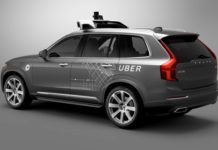LOS ANGELES—While not an auto technology show, this year’s Mobile World Congress Americas featured a track on autonomous and connected vehicles that highlighted the continued importance of future 5G technology.
The new 5G technology will be critical to such companies as Drive.ai as network LTE applications are not quite robust enough, said Brody Huval, Drive.ai co-founder. “We want to know if it is safe for a vehicle to make a choice to go around a certain garbage truck. We have seven cameras and sensors that monitor the vehicle’s health including heat and power consumption,” he said.
In terms of current LTE and 4G technology, Huval says they aren’t good enough for autonomous driving. “We need [technology] to allow 5G imagining data from cars and stream it back for teleoperation for one operator [to control a fleet]. This means high-resolution data so cars can update maps. Right now, cars have to park, rely on a hard-disk drive to upload. It’s still too long a lag time, rather than having real-time map updates.
Another drawback is the ability for driverless cars to work in all weather conditions, Huval said. “A lot of them are unable to deal with the weather,” he said. “We also want autonomous vehicles to have [less expensive] solid state radar and LiDAR, with [artificial intelligence] as part of that layer.”
In a separate interview at MWCA, the head of 5G Americas says that connected and autonomous vehicles will be safer with the new technology. “If you look at the capability of 5G, you start to think of a vehicle as a connected smart computer. It will react quickly and process massive amounts of information,” said Chris Pearson, 5G Americas president. “Even though LTE is in a lot of vehicles, when you get the enhanced network capability and speed, low-latency communications—it improves mission capability and safety. More licensed spectrum and a well-managed network are critical to autonomous vehicles.”
Pearson said the association is working on issues surrounding connected and autonomous vehicles through a 3rd Generation Partnership Program standards project. He said 5G Americas also offers a vehicle-to-infrastructure, V2X, white paper on its website.
“Our paper talks about the benefits of our technology and that of DSRC [dedicated short-range communication], which hasn’t changed much recently. We’ll see where it all ends up,” he said. “When you are looking at vehicle-to-everything, that means pedestrians, infrastructure, stop lights, car advertisements—everything is going to be connected.”
Besides the Safety Argument, Why Autonomous Vehicles?
The economics of autonomous vehicles will spur development, said Omar Hoda, Deloitte U.S. Automotive principal. “It’s a dollar a mile to move a person. With asset sharing, it [falls] to 60 cents per mile,” he said. “When you converge all of the autonomous vehicle trends, it falls to 30 cents a mile.”
Hoda says the development of autonomous vehicles will be two-dimensional in that people will own cars for years until fully shared fleets begin to be introduced.
Because of a new generation not wanting to own a car—or even drive one—the case for autonomous vehicles is compelling, said Erik Antonsson, aiPod president and CEO. “Owning a car is a pain in the neck,” he said. “Those use [auto] patterns are going to completely change. The idea that cars will be command and controlled, rather than individually owned. The most profound thing is that individual car ownership is the second largest expense—it’s a crazy model if you think about it.
Investments in Autonomous Vehicles Strong…
One company is investing in logistics companies, smart cities and others that leverage autonomy as part of their business. “We are investing in transportation logistics. Fifteen companies in the smart commuting, smart cities and smart logistics that leverage technology better with autonomy,” said Paul Asel, Nokia Growth Partners managing partner.
Asel said Nokia is also investing in companies in valet parking, warehouse operations, drones, fleet platooning and mining. “Bosch is piloting a program in Stuttgart, [Germany]. In the U.S. Clearpath and Otto are using autonomous vehicles in warehouses,” he said. “In Chile and Australia, mining operations have used autonomous vehicles for 10 years without incident. One of our portfolio companies, Peloton, is using platooning to save 10 percent of trucking fuel cost—with the last vehicle driverless.”
Asel said the early autonomous vehicle adopters will be smart cities in the United States; autonomous navigation systems in Israel through Waze; public transportation in Europe through such companies as Navya; and artificial intelligence in China, as the government is spending two-to-three times more than other countries on infrastructure research and development.
The Disruption…
While much has been written about autonomous vehicles’ disruption, Hoda said that such traditional industries as vehicle financing, a $100 billion business, will be shaken up as people give up car ownership.
“The number of industries disruptive is quite remarkable. Very broad industries such as cyber players with car connectivy, energy companies. It’s a very diverse group,” he said. “What happens to that average 55-minute commute or average time in the vehicle? Most cars are single occupancy. That’s a whole hour of increased productivity or watching Netflix.”
In addition, Hoda said that insurance coverage will move away from comprehensive to catastrophic models; cars will be energy-saving electric powered; public sector revenues of licensing, auto and fuel tax will be turned upside down. “Public parking alone averages $32,000 per parking spot. The real estate market will be effected on second- and third-levels,” he said.
Antonsson says his company’s focus is on smart cities and associated infrastructure, rather than the car itself. “We are focused on the cities as half of the world population lives in [them],” said Erik Antonsson, aiPod president and CEO. “This will make an unprecedented impact on mobility to share. But to be focused solely on the vehicle is like creating a red blood cell and ignoring the circulation system.”
Antonsson said aiPod is working on a pilot project in London to develop autonomous vehicle simulations. He says the multi-billion-dollar opportunity is accessing risk for insurance companies and simulation testing.




























